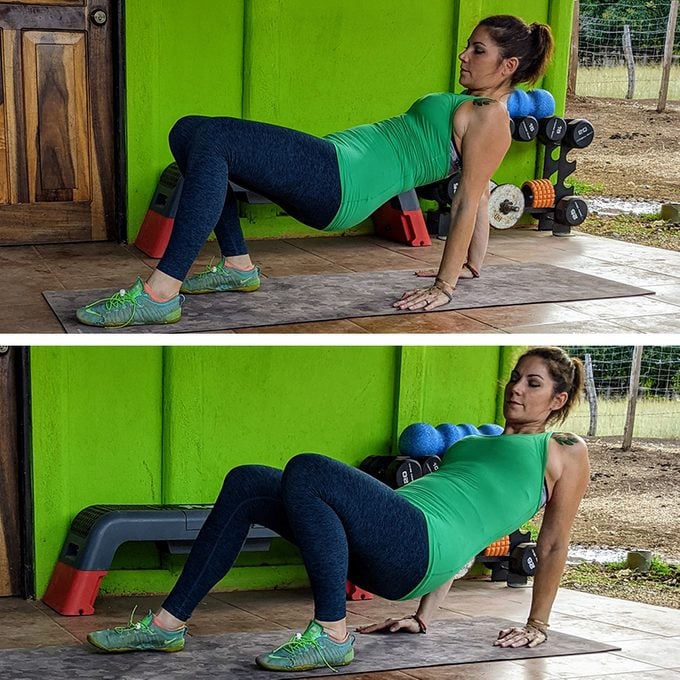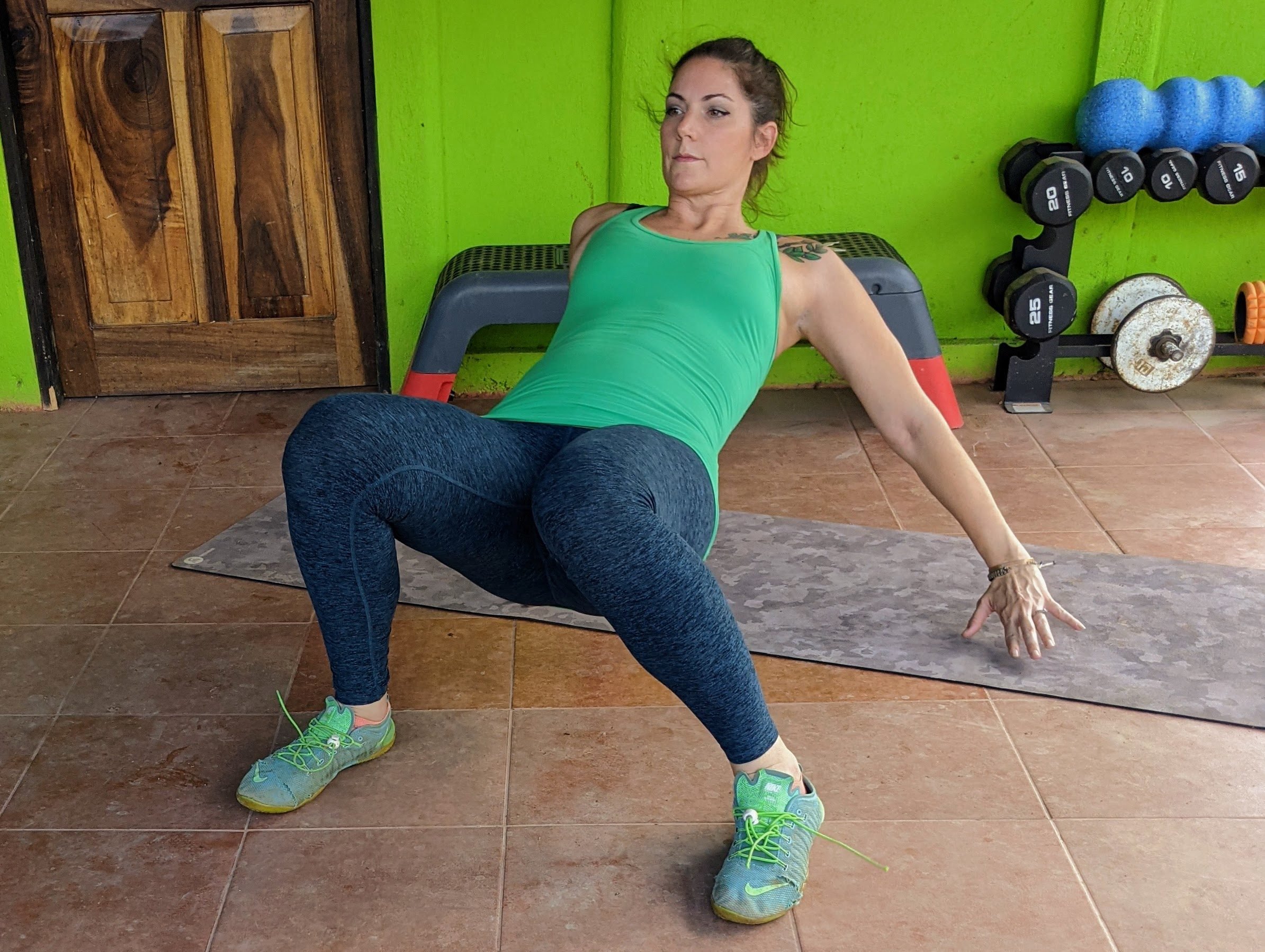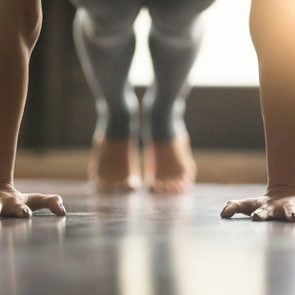How to Do the Crab Walk Exercise for a Full-Body Workout
Updated: Apr. 28, 2021
Crab walk exercises can strengthen and tone your core, arms, and legs. Here's how to do them correctly.
What’s the crab walk exercise?
Chances are you haven’t gotten down on all fours to do a crab walk since you were back in elementary school, doing relays with your friends for field day.
But the crab walk is an easy, bodyweight-only exercise that can be incorporated into home-based workouts to add new, slightly-nostalgic life to your standard workout routine.
“A crab walk is an excellent full-body move that utilizes your core and upper body,” says Holly Roser, a certified personal trainer and owner of Holly Roser Fitness in San Francisco. “This move helps elevate your heart rate and can be considered high-intensity interval training (HIIT) if you’re really speedy,” she explains.
Is the crab walk like HIIT?
If you’re thinking, “The crab walk is like HIIT?! No way! I used to speed across the school gym without breaking a sweat!” Roser says. That’s just more evidence you haven’t tried it in a while. For one, you may not remember how challenging it was way back in the day. (Memory can be funny that way.)
But more to the point, how often do you find yourself supporting your entire body weight on your palms and feet, awkwardly shuffling your entire body weight forward in a semi-coordinated effort of “steps” with all four limbs? I’d argue, not very often.
It’s harder than you likely remember. And as you move, you’ll quickly start feeling the burn in your forearms, triceps, shoulders, glutes, back, hamstrings, and abs. Really, it’s a full-body exercise when it comes right down to it.
(Try this strength training routine that works your whole body.)
Is the crab walk safe for everyone?
Since it’s a full-body workout, it’s important to start slow and incorporate the move into shorter bouts of exercise, rather than extended attempts.
If you find you’re not quite ready for it, keep up your other workouts to build total strength and coordination before trying it again down the line.
“This move is an advanced move with excellent benefits for overall strength, but I’d recommend it for someone who has been working out for at least six months,” says Roser.
She adds that aches, pains, and injuries you’ve accumulated over the years may prevent it from being comfortable.
“If you have shoulder impingements, arthritis in your hands, wrist injuries, or lower back pain, you may find the crab walk isn’t a good option for you,” she says.
(This is the best workout for every age.)

How to do the crab walk
The crab walk is simple enough (theoretically) to perform, and you can make adjustments based on how much room you have to work with to move around, but it’s helpful if you have at least 10 feet of available space to crawl back and forth in.
Start sitting on the floor with your knees bent, feet flat on the ground, placing your palms on the floor behind your hips, your fingers pointing forward. Engage your core and glutes and lift your hips off the floor so you’re fully supported by your feet and palms.
In a controlled fashion, “step back” with your right hand, then your right foot, following suit with your left hand and left foot.
Continue moving backward within the space you have in this controlled shuffle. When you’ve gone 10 to 15 feet, reverse the movement, and “walk” forward leading with your right foot and right hand before following with your left foot and left hand.
Continue for a pre-determined interval length ranging from 10 to 60 seconds.
(Try these 60-second exercise moves for a quick workout.)
How to add a crab walk to your strength workout
A crab walk is good to add as part of an interval routine, not as a stand-alone exercise. In other words, you don’t want to head to the local gym and just start crab-walking around the gym for 30 minutes. (There’s no way you would last… at least not without a lot of ongoing practice and conditioning.)
Rather, Roser suggests using the crab walk as a quick cardio-boost between strength exercises.
“For example, you could do three sets of 15 squats and use your crab walk as an interval in-between instead of resting between sets,” she says.
When including crab walks as an interval between strength exercises, aim to complete the exercise for 30 to 60 seconds.
If you find you become too tired to continue the “walking” part, simply hold the crab position in place, lifting your hips as you contract your core, upper back, shoulders, triceps, and glutes to remain steady.
(Add these squat exercises to your workout to tone your body.)
How to add a crab walk to a HIIT workout
You can try a Tabata-style interval workout that includes a crab walk as a component, along with other cardio-boosting moves.
Tabata is HIIT workouts that incorporate exercises that last four minutes. Consider this challenging option (use a Tabata timing app to help manage your intervals) when you want to break a sweat with a no-equipment workout at home.
Repeat the series twice (for a total of eight intervals, or four minutes) before taking a two-minute break. Complete a total of two to four rounds.
-
20 seconds, crab walks
-
10 seconds, rest
-
20 seconds, jumping jacks
-
10 seconds, rest
-
20 seconds, bear crawls
-
10 seconds, rest
-
20 seconds, skaters
-
10 seconds, rest
-
Repeat a second time through
Crab walk variations
The basic crab walk is pretty straightforward, but there are ways to mix it up if you’re looking for more of an ab workout or balance challenge. Try any of the following to mix things up.
Crab oblique crunch
The crab oblique crunch exercise is a way to challenge your balance while incorporating a little more oblique work into the basic crab position.
Start in the reverse tabletop position on your hands and feet, your hips lifted from the ground. Engage your core and simultaneously lift your left palm and your right foot from the ground, simultaneously drawing your left elbow and right knee across your body to meet in the middle as a type of modified cross-body crunch.
Return your left palm and right foot to the floor and repeat to the opposite side. Continue for 30 to 60 seconds, or for the length of your designated interval.
(Try these balance exercises.)

Lateral crab walk
If you get tired of crab-walking forward and backward, you can try the lateral version instead. This will help incorporate hip and shoulder abduction and adduction (these lateral movements) into your routine.
Start in the same reverse tabletop position on the ground, supported by your hands and feet with your hips lifted.
“Step” to the right with your left palm and left foot, followed quickly by your right palm and right foot. Continue this sideways crab shuffle for about 10 feet, then reverse the movement and head back to the starting location, now leading with your left palm and left foot. Continue for 20 to 60 seconds as part of your predetermined interval.
(Here are some thigh exercises to help tone your legs.)
Crab abs for balance
If you find that crab oblique crunches are entirely too easy, amp things up by giving crab abs a try.
The concept is the same—the exercise further targets your core muscles and challenges your balance while still working the muscles used when doing a moving crab walk.
Start in your reverse tabletop position, supported on your hands and feet with your core engaged and hips lifted from the ground.
In a simultaneous movement, reach and fully extend your right arm and your left leg toward the ceiling, aiming to touch your left foot with your right palm.
Do this with as much control as you possibly can, slowing the movement as needed to assist with balance. Return the right palm and foot to the ground before repeating to the opposite side.
Continue alternating sides for 20 to 60 seconds as part of your predetermined interval.
Next, here are some other at-home workouts to try.

















